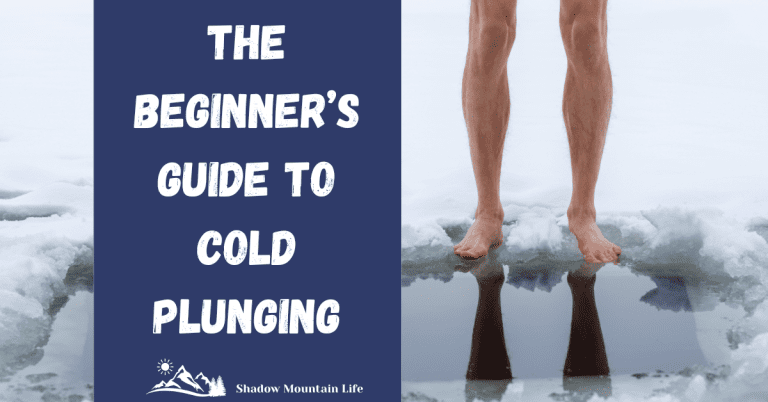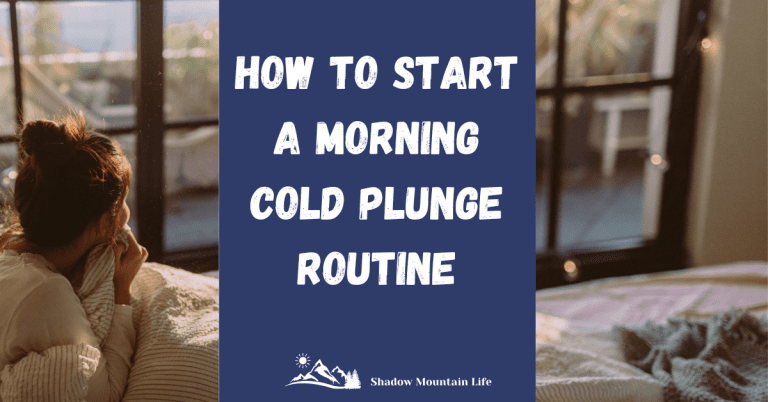Cold Plunging vs Cryotherapy: An Icy Complete Guide (Cost, Benefits & Results)
If you are looking at using cold therapy, you may have questions about cold plunges vs cryotherapy. Which one is better? Whether you’re an athlete or someone seeking better health, both cold plunge and cryotherapy can boost your health and recovery.
Medical Disclaimer: We are not doctors. The health information in the article is for informational and educational purposes only. Please consult your doctor or other healthcare professional when making medical decisions.
Affiliate Disclaimer: We may make a commission if you purchase something through our links. Thank you!

Understanding the Basics: Cold Plunging vs Cryotherapy
Cold plunges (sometimes called ice baths) and cryotherapy are two completely different experiences, but both work well for a recovery routine.
First up, cold plunging is exactly what it sounds like – you’re immersing your whole body in seriously cold water, typically between 38-45°F (3-7°C). You usually stay in for 2-5 minutes, though at first you may only manage 30 seconds! The water gives you that immediate “fight or flight” response but then your body starts to adapt if you continue in the practice.
Whole body cryotherapy is completely different. When you step into a cryo chamber, you’re dealing with temperatures around -200°F (-129°C) or colder, using nitrogen gas to create that intense cold. The sessions are super short though, usually just 2-3 minutes max. Cryotherapy uses a dry cold-no liquid involved at all.
Cold plunges (or ice baths) use simple thermodynamics – water, ice, and maybe a chiller system. Pretty straightforward stuff. Cryotherapy chambers, on the other hand, are high-tech machines that look like something out of a sci-fi movie, using liquid nitrogen to create that ultra-cold environment.
The main difference in experience? Cold water immersion gives you that all-over, consistent cold sensation because water conducts temperature so effectively, and you may actually feel colder despite the higher temperatures in the cold plunge. Cryotherapy is a colder temperature but somehow less penetrating.
The Beginner’s Guide to Cold Plunging: Cold Water Therapy and 5 Powerful Health Benefits
Comparing the Costs: Investment vs. Value
Starting with cold plunges, you’ve got a few different routes. A basic DIY setup with a stock tank and ice bags might run you $300-500, but honestly, that gets old real quick-you will get tired of buying ice. The more practical home cold plunge systems range from $2,000 for basic models up to $10,000+ for the fancy ones with built-in chillers. Plunge has a nice tub with an external chiller for around $5,000.
Now for cryotherapy – this is typically a pay-per-session deal at specialized centers. Single sessions usually run between $60-100, but most places offer monthly memberships that can bring the per-session cost down to $30-50.
Be sure to consider the ongoing costs of cold plunges: you’re looking at electricity costs to keep the water cold, plus periodic filter changes and cleaning supplies. Still, if you use it regularly (4-5 times a week), it ends up being way more cost-effective than cryotherapy in the long run.
Quick math: if you do three sessions per week, annual costs look something like this:
– Cold plunge: $4,500 upfront + annual maintenance
– Cryotherapy: $4,680 annually ($30 per session × 3 sessions × 52 weeks) + gas and time to get to the fitness center
Bottom line? Cold plunges are a better investment if you’re in it for the long haul and have the space. Cryotherapy makes more sense if you want to try it out first or don’t want to deal with maintenance hassles.

Health Benefits and Scientific Evidence
Let me share what both research and personal experience have taught me about the health benefits of these cold therapy methods!
Benefits of Cryotherapy
Cryotherapy has some impressive research backing although it is almost all done on athletes, usually males in most studies.
1. Reduced Inflammation and Pain: Cryotherapy can help reduce pain and inflammation in the body. People with chronic back pain found relief with cryotherapy treatments in a 2015 study from the European Journal of Physical Rehabilitation Medicine.
2. Performance Recovery: Cyclists who were tested by cooling down halfway through an athletic event were shown to have better max effort at the end of the event per the Journal of Science and Medicine in Sport.
3. Improved Mental Health and Decreased Stress: A 2014 study of rugby players showed that cortisol levels were decreased after daily cryotherapy treatments.
4. Helps Strengthen Immune Function: A study in 2015 showed that people who regularly had cryotherapy treatments had an increase in their white blood cell count.

Benefits of Cold Plunging
Cold plunging and cold-water immersion therapies have been around much longer and therefore have more research to draw from.
1. Neuroprotection for the brain: Exciting research is being done to discover whether cold water swimming and cold water plunging can be used to prevent brain degeneration such as in Alzheimer’s. These cold shock proteins have been shown to protect the brain in mice and further research is being done to find out if these benefits are translated to humans as well.
2. Numbs Nerve Irritation: Ice baths immediately provide relief from nerve pain by numbing the source of discomfort.
3. Reduced Inflammation: Studies from the European Journal of Applied Physiology showed that cold water baths after exercise reduced inflammatory markers in the body.
4. Improved Mental Health A study from Medical Hypothesis showed that a cold shower/cold plunge could have antidepressant effects on the body.
Both Have Benefits for Your Body
Cold therapy in general provides many of the same benefits as cold plunging and cryotherapy do individually. A few common benefits of exposing your body to cold therapy includes:
1. Increased Immune Function and White Blood Cell Production: Cold therapy has been shown to increase glutathione production which helps your white blood cells work correctly and efficiently.
2. Metabolic Boost and Possible Weight Loss: Cold therapy has been shown to increase Vitamin A levels in humans. This increase in Vitamin A turns “bad” white fat into “good” brown fat and increases metabolism and fat burning.
3. Decrease Pain: Cold therapy can reduce the perceptions of pain by using breathing techniques and cold exposure together.
Research continues to come out on the benefits of cold therapy-either by cold plunging or cryotherapy and the benefits it has for the human body.
But here’s what most people don’t talk about – the adaptation period. Your body does need time to adjust to either method.
The most solid scientific evidence points to both methods being effective for reducing inflammation and improving recovery times. However, cold plunges have more research behind them simply because they’ve been around longer. The newest studies on cryotherapy are showing promising results for autoimmune conditions and chronic pain management, though we need more long-term research to fully understand the benefits.

Accessibility and Convenience Factors
For cold plunges at home, you need to think about space as well as a convenient place to fill and drain the tub. Plus, if you’re renting, you’ll need to check if your landlord is ok with the installation.
Cryotherapy is a different story entirely. While you don’t have to worry about installation, you’re at the mercy of local availability. In major cities, you might find several cryo centers within a 15-minute drive. But in smaller towns? You might be looking at quite a trek.
Time commitment is another huge factor. With my home cold plunge, I can hop in whenever – even at 6 AM before work or late at night after a workout. The whole process takes a few minutes, including prep time. Cryotherapy sessions, though technically shorter (2-3 minutes), end up taking way longer when you factor in driving time, changing clothes, and waiting your turn.
Safety-wise, both methods need some attention. Cold plunges require regular maintenance to keep the water clean and at the right temperature. With cryotherapy, you’re relying on trained professionals and well-maintained equipment, which is honestly a big plus if you’re nervous about cold exposure. Just remember – with either method, you never want to start out doing it alone.

Results and Effectiveness Timeline
With cold plunges, you’ll feel the immediate effects (reduced muscle soreness and mental clarity) within your first session, but the really interesting changes start happening after about 2-3 weeks of consistent use.
Cryotherapy results tend to be more intense but shorter-lasting. You get that immediate endorphin rush and energy boost that can last 6-8 hours. But you may need more frequent sessions to maintain the benefits. While a cold plunge’s effects seem to build up over time, cryo benefits tend to be more “use it or lose it.”
For athletic recovery, both methods work great, but there’s a key difference: cold plunges seem to provide deeper tissue penetration since water conducts cold better than air.
Making the Right Choice: Personalized Recommendations
Cold plunges are perfect for the dedicated home-recovery enthusiast. If you’re someone who works out 4+ times a week and values flexibility in your recovery timing, a cold plunge could be your best friend. They can work amazingly well for remote workers and parents who need that recovery on their own schedule. For example, a busy mom who trains for marathons can easily fit in a morning plunge routine at home since it fits perfectly between getting the kids ready and starting her workday.
Cryotherapy tends to be the better choice for a few specific groups. First, apartment dwellers or anyone without space for a cold plunge setup. Second, those who prefer a supervised, controlled environment – especially if you’re new to cold exposure therapy. It’s also great for people who want to test the waters before committing to a home setup.
You can always start out and try cryotherapy first. It’s controlled, supervised, and lets you experience extreme cold without a major commitment. You can always transition to a cold plunge later if you love the benefits.
But if you’re already sold on cold therapy then a cold plunge might be your better bet. Just remember – consistency matters more than which method you choose
Check out our 5 Best Cold Plunge Tub recommendations
Whether you choose a cold plunge or cryotherapy largely depends on your specific needs, budget, and lifestyle. Both methods offer powerful benefits for recovery and health optimization. Consider starting with a few sessions of each to experience the differences firsthand.
Ready to take the plunge into cold therapy? Start with what aligns best with your goals and lifestyle and adjust as needed!







